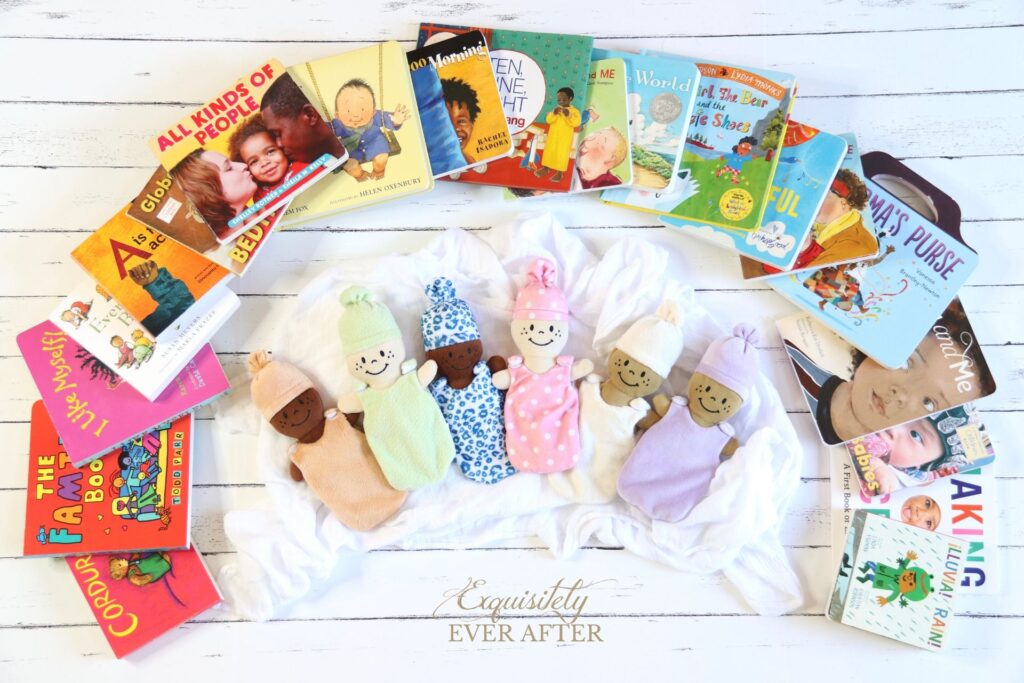
Some links are affiliate links. Please see more here.
SUMMARY: In this episode we discuss 21 of the best diverse board books for infants, toddlers, and even grown-ups! Studies show that children start to look more at faces that match the faces of their caregivers by just 3 months of age; by 2 years old, they start using race to reason about people’s behaviors; and by two-and-a-half, most children use race to choose playmates. Systemic and structural racism needs to be countered with intentional action from birth and, in order to do so, infants and toddlers should be surrounded with positive narratives and images of Black, Indigenous, and other people of color. Reading books to very young children that feature Black people, Indigenous people, and other people of color is one of the best and easiest ways to make sure your infants and toddlers see and celebrate diversity as they grow.
Listen to the Podcast Episode:
Books Mentioned in this Episode:
*Global Babies produced by The Global Fund for Children
*Global Baby Bedtimes produced by The Global Fund for Children
Global Baby Girls produced by The Global Fund for Children
American Babies produced by The Global Fund for Children
Global Baby Boys produced by The Global Fund for Children
*Making Faces: A First Book of Emotions an Abrams Appleseed Book
*All Kinds of People by Shelley Rotner and Sheila M. Kelly
*Everywhere Babies by Susan Meyers, illustrated by Marla Frazee
*All the World by Liz Garton Scanlon, illustrated by Marla Frazee
Worm Weather by Jean Taft, illustrated by Matt Hunt
*The Family Book by Todd Parr
*Mommy, Mama, and Me by Lesléa Newman, illustrated by Carol Thompson
*Daddy, Papa, and Me by Lesléa Newman, illustrated by Carol Thompson
*Ten Little Fingers and Ten Little Toes by Mem Fox, illustrated by Helen Oxenbury
We’re Going on a Bear Hunt by Michael Rosen, illustrated by Helen Oxenbury
*Peekaboo Morning by Rachel Isadora
*Ten, Nine, Eight by Molly Bang
Goodnight Moon by Margaret Wise Brown, illustrated by Clement Hurd
*What A Wonderful World based on the song by Bob Thiele and George David Weiss, illustrated by Tim Hopgood
*You and Me by Rebecca Kai Dotlich and illustrated by Susan Reagan
*Corduroy by Don Freeman
Corduroy 40Th Anniversary Edition by Don Freeman
Anne of Green Gables by L. M. Montgomery
*I Like Myself by Karen Beaumont and illustrated by David Catrow
How The Grinch Stole Christmas by Dr. Seuss
*Grandma’s Purse by Vanessa Brantley-Newton
Mary Poppins by P. L. Travers
*The Girl, The Bear, and the Magic Shoes by Julia Donaldson, illustrated by Lydia Monks
The Gruffalo by Julia Donaldson, illustrated by Axel Scheffler
Room on the Broom by Julia Donaldson, illustrated by Axel Scheffler
Zog by Julia Donaldson, illustrated by Axel Scheffler
The Singing Mermaid by Julia Donaldson, illustrated by Lydia Monks
The Smeds and The Smoos by Julia Donaldson, illustrated by Axel Scheffler
What the Ladybird Heard by Julia Donaldson, illustrated by Lydia Monks
Princess Mirror Belle Books by Julia Donaldson, illustrated by Lydia Monks
*Rain! by Linda Ashman, illustrated by Christian Robinson
¡Lluvia! Rain! by Linda Ashman, illustrated by Christian Robinson, bilingual edition
Last Stop on Market Street by Matt de la Peña, illustrated by Christian Robinson
*A is For Activist by Innosanto Nagara
*Antiracist Baby by Ibram X. Kendi, illustrated by Ashley Lukashevsky
How to Be An Antiracist by Ibram X. Kendi
Stamped from the Beginning: The Definitive History of Racist Ideas in America by Ibram X. Kendi
Note: Books marked with * are the focus books of this episode.
Diversity in Children’s Books Infographic
Podcast Transcript:
Today we’re going to be doing a roundup of 21 excellent diverse board books for babies, toddlers and for grown-ups. As I mentioned in Episode 6, I have been doing a lot of research and self-examination these past couple of months trying to figure out how I can become more antiracist and use my privilege and my voice to take meaningful action in my own life to counter structural racism and socialization against Black people, Indigenous people, and other people of color. And I have also been examining the way that I talk to my two little boys about race, racism, diversity, and inclusion and working on how I can better model attitudes of openness and acceptance so that they see, appreciate, honor, and respect our differences as a global community as much as they celebrate what makes us the same. Obviously, as you all know, I really believe in the power of children’s literature, so to help me in my efforts (again, as I talked about in Episode 6), I have been reading a lot of diverse books to my preschooler and my toddler so that they, too, can grow into accomplices that will work to dismantle institutionalized racism and work on achieving equity, inclusion, fairness, and justice for everyone. I have been making a conscious effort since my first son James was born to fill my kids’ bookshelves with diverse books. Part of the reason for this is that my PhD, while it’s in Children’s and Young Adult Literature, it’s from the Department of Comparative Literature, so I’ve definitely seen the value in reading books from all kinds of cultures and ethnicities in my own life. Reading these books, often in their native languages, really broadened my perspective and, I think and I hope, made me a more empathetic person, and so, right from the beginning, I wanted my kids to have that experience, too.
But here’s one thing I noticed these past two months about the collection of books that I assembled for my children that really troubled me and that I found unacceptable and that I’m trying to change: While we have a lot of diverse picture books in our house, we have very few diverse board books for very young children. We have some, but, quite frankly, they only make up a fraction of our collection of board books which, admittedly, is verging on hoarder-status. We have board books everywhere in our house because I want them to be easily accessible, but, it’s, like, getting out of control. But that’s a story for another day… Anyway, I was disappointed in myself because I know that systemic and structural racism needs to be countered with intentional action from birth and, in order to counter it, even infants and toddlers should be surrounded with positive narratives and images of Black people, Indigenous people, and other people of color. Studies show that children start to look more at faces that match the faces of their caregivers by just 3 months of age; by 2 years old, they start using race to reason about people’s behaviors; and by two-and-a-half, most children use race to choose playmates. So, reading books to very young children that feature Black people, Indigenous people, and other people of color is one way to make sure that your infants and toddlers see diversity in a positive light. And yet my collection of board books didn’t reflect my values. So, in order to remedy this, I went online and started to seek out diverse books in board book format that were targeted specifically for infants and toddlers. And, to be honest, they were very difficult to find and when I did some research on why, the answer was even more troubling.
In 2018, the Cooperative Children’s Book Center at the School of Education at the University of Wisconsin-Madison (known as the CCBC) documented some publishing statistics on children’s and young adult books about people of color and First Nations and by people of color or First Nations authors and illustrators. Dr. Sarah Park Dahlen and illustrator David Huyck created a powerful infographic based on these statistics that I’ll link in the shownotes. What they found was that in 2018 there were more children’s books that featured animals and other non-human characters than all types of visible minorities combined. The children’s books featuring animals and other non-human characters made up 27% of the total, while those featuring all types of visible minorities combined made up only 23%. Meanwhile, half of all the children’s books that were reviewed featured white characters. And this is what that looks like if you, like me, aren’t great at statistics: 1,558 books had white characters; 864 books had animals or non-human characters; while only 301 books had Black characters; only 218 had Asian Pacific Islander/Asian Pacific American characters; only 170 had Latinx characters; and only 23 had First Nation/Native Americans.
But here’s the deal, this study is for all of the children’s books and young adult books published in the United States. That means that this isn’t just picture books and board books, but chapter books and novels. So, the number of diverse books for toddlers and infants is likely even smaller because a lot of the time, it’s books for older children that include diverse characters rather than books for the younger ones. Additionally, regarding the infographic which depicts a white boy and a bear looking into shiny, clear mirrors while depicting children of color, both male and female, looking into cracked and distorted mirrors, Professor Dahlen wrote that: “Children’s literature continues to misrepresent underrepresented communities, and we wanted this infographic to show not just the low quantity of existing literature, but also the inaccuracy and uneven quality of some of those books.” And I have to say that I completely agree with Dr. Dahlen. Not only did I find that most of the board books that we already owned portrayed animals rather than people and that when there were people, they were white people, while I was searching for diverse board books to add to our collection, it was really difficult to find books that I thought were of high quality as far as being accurate, brain-building, and engaging. I actually had an easier time selecting excellent diverse picturebooks when I was making a list for slightly older children, partly because there are more picture books in existence than board books, but also because unfortunately I think people might not see the urgency for more representation in books for infants and toddlers.
However, I did manage to find 21 books that I really like and that my children really like out of the 50 or so that I ordered, and today I’m going to share them with you. In their report, the CCBC urges people to buy and share more books featuring diverse characters because sales really matter to publishing. So if you, like me, are looking to expand your young child’s library, hopefully my choices today will be helpful to you, too. My intention with this podcast is to try to make things as straightforward and as easy for parents and caretakers as possible, so, as always, I’m going to list and link all of the books in the shownotes so you don’t have to stop what you’re doing to write them down. You can just click on the link in the shownotes or you can go directly to exquisitelyeverafter.com/episode10 at whatever time is convenient for you to find that list. And I’ll also put the link to my list of 50 Diverse PICTURE Books there, too, in case you want to build up your child’s collection of diverse picture books in advance or if you also have older children and you’re looking to read more diverse books to them. Of course, you can always also purchase these books from independent bookstores or request them from your library. I’ve made both lists into PDFs so you can download them onto your phone or print them out and take them with you. Whatever way you do it, it’s great because it helps send the message to publishers that we need and want more diverse books for our kids.
Okay, without further ado, here are the books:
First up are a few books that are great for newborns and infants. I talked a lot about why you should read aloud to your newborns and what kinds of books you should read to your newborns and infants in Episode 4 and Episode 5, so if you haven’t listened to those yet and you want to learn a bit more about why I think these books are great for this age group, I recommend that you go back and listen to those episodes. Because I have so many books to get through today and I know you all have really busy lives, I’m going to keep my comments about each book really brief—well, okay, as brief as I possibly can as a very chatty person. For a Greek girl like me, it’s a never-ending struggle.
Anyway, the first two board books are both Global Fund for Children Books so part of the proceeds from these books’ sales are donated to the Global Fund for Children which supports innovative, community-based organizations that serve the world’s most vulnerable children and youth. The first is called Global Babies and the second is called Global Baby Bedtimes. There are also more in this series like Global Baby Girls, American Babies, Global Baby Boys, and so on, and I received several in this series at my baby shower the first time around, but the two that my both of my children seemed to like best are Global Babies and Global Baby Bedtimes. These books aren’t stories, but rather just images of babies from around the world. The text of Global Babies tells us “Wherever they live, wherever they go, whatever they wear, whatever they feel, babies everywhere are beautiful, special, and loved,” and set to this text are photographs of babies from a variety of ethnicities and cultures.
In Global Baby Bedtimes, the photographs are of global babies sleeping in a variety of locations, like in a cradle or on the floor or in their parents’ arms or on their backs. As I mentioned in Episode 5, newborn babies and infants have an innate preference for faces (or facelike objects), so these two books with their closeups on the baby’s faces really attract a young child’s attention. And, additionally, I like that by showing your baby images of people from a variety of cultures and ethnicities, you are promoting a positive association of diversity from the very beginning. When you read this book to your child, you can point to each baby and say “baby!” so that way your child can learn to associate the word “baby” with infants who aren’t just blond, blue-eyed, white babies, as so many previous children’s books have emphasized.
Making Faces: A First Book of Emotions
Another great book for the newborn and young infant stage that I talked about in Episode 5 is an Abrams Appleseed book called Making Faces: A First Book of Emotions. This book is meant to appeal to slightly older infants and young toddlers who are learning about feelings, but my son Luke really loved looking at the baby faces when he was a newborn and throughout his first year of life. Like the Global Babies books, it, too, is comprised of photographs of baby faces, but this time it focuses on the emotions that these babies exhibit like happiness, sadness, surprise, and so on.
And there is a fourth book that is comprised of photographs of children that I like called All Kinds of People, by Shelley Rotner and Sheila M. Kelly. This book is again for slightly older infants and young toddlers. It begins, “There are all kinds of people. They come in many shades,” and then the rest of the book shows children from a really wide variety of ethnicities and with a wide array of skin tones. I like this book because it has a lot of really rich, descriptive color language like “sandy,” “peach,” “almond,” “copper,” “ivory,” and “bronze” and it explains very clearly to children that we all have varying shades of color. This is important because studies show that even infants can distinguish skin tones and we know now that downplaying racial difference, what’s known as “the colorblind approach” to diversity, isn’t effective in teaching children to celebrate and embrace the differences in humanity. By early childhood, kids begin to have more favorable opinions of people they perceive as “the same” as they are, so it’s crucial that we start early when we talk about the value of diversity and also show our kids just how varied and nuanced our human features can be.
Okay, next up is a book that, again, celebrates global babies and shows people with a wide variety of skin colors and facial features and that is Everywhere Babies by Susan Meyers and illustrated by Marla Frazee. This book, however, is more of a traditional board book in that it has a rhyming text set to illustrations, which, as we discussed in Episode 1, is perfect for toddlers. It begins, “Every day, everywhere, babies are born: fat babies, thin babies, small babies, tall babies, winter and spring babies, summer and fall babies…” And the book continues with this refrain, “Everyday, everywhere babies are…” and then it describes them and their lives. So, “Everyday, everywhere babies are… fed, rocked, carried, they make noise, play games and play with toys, they make friends, they crawl, walk, and grow, and they are completely loved by the people who take care of them. I really like this book because it’s so reassuring and comforting to young children who love seeing and hearing examples of little people like them being kissed, held, rocked, and adored. And I of course love that the images are very inclusive, representing not only a wide-variety of races and ethnicities, but also lots of different types of families, like families who have parents of different races, families with two moms and two dads, and families with single parents. I love the illustration on the page where it shows babies being carried because there are so many different types of people and so many different ways to get a baby from Point A to Point B. The illustration at the soft play center that shows the simultaneous chaos and adorableness that exist at a playgroup is also really well done. Really, all of the illustrations are so endearing, expressive, and affectionate. I particularly love the one vignette of the mother who has fallen asleep while breastfeeding on a rocking chair with a book open in her hand. I found that one particularly relatable. Marla Frazee gives us a window into everyday life with babies in all of its beautiful mess and exhaustion and hilarity and bewilderment and joy and, in so doing, she shows us how this unique season of life is universal for all kinds of families. She really deepens the emotional moments while also reinforcing the humorous ones. And just one more thing before we move on: because the text is so repetitive and lyrical, and the message is so reassuring, it’s also perfect for bedtime. I definitely recommend this book as a good option to read every night before bed.
And speaking of Marla Frazee’s beautiful illustrations, she is also the illustrator of our next book, All the World, which earned a Caldecott Honor and was written by Liz Garton Scanlon. This book is written in verse as well, although it reminds me more of spoken word poetry than of a traditional metered poem. It actually reminds me of the poetic style of Worm Weather, which is a book that I talked about in Episode 2. The story/poem follows a circle of family and friends throughout the course of a day. It begins:
Rock, stone, pebble, sand
Body, shoulder, arm, hand,
A moat to dig, a shell to keep,
All the world is wide and deep
And each stanza describes the experiences that this family and friend circle has throughout the day, and each experience ends with the words “All the world… is old and new” or “All the world is… cold and hot” or “All the world… can hold quite still” or “All the world… goes round that way.” In this way, Liz Garton Scanlon describes to us an intimate family experience, but also demonstrates its universality and thereby simultaneously affirms the beauty of all things great and small in our world. I like how she is able to zero in and pay very close attention to small details like a tomato blossom, or the way a child might tip a bucket and spill all of its contents, or the way “the morning sun becomes noon-blue.” They offer the child reader a way to become absorbed in the little wonders of everyday life, just like your toddler does in real life when you, you know, say, go for a walk and she notices all the acorns on the ground or watches the way the wind blows through the grass.
And I think that Marla Frazee’s illustrations contribute so much to the narrative and the messages of this book, in some ways even more than the actual words do. Her watercolor and pencil drawings are so detailed and they really give shape to the story that this book is telling; it’s almost as if the words are just there to highlight certain moments, rather than the other way around with illustrations highlighting the words, which is how picture books usually operate. Marla Frazee seems to really respect the mastery that small children have when they look at pictures. Because they can’t yet read the words, they read and focus on the images and Marla Frazee seems to understand that little kids have a level of skill and discernment when looking at illustrations that we adults don’t have anymore because we divide our attention between the words and pictures. So she really caters to perceptive toddlers and preschoolers in the way that she gives them a lot to observe and absorb and appreciate in all of her little vignettes as well as in the larger two-page spreads. I just love the respect and admiration that she demonstrates for her child readers.
And, just one more quick thing because this episode is all about diverse board books: All the World definitely exhibits an atmosphere of inclusion. As in Everywhere Babies, All the World shows us a family and friend circle that includes people of different races within the same family, as well as same-sex couples, and it ends “Hope and peace and love and trust, All the world is all of us.”
Oh! And one more completely unrelated thing, but something that just makes me happy as a Marla Frazee illustration fan: there is another image of a mother reading or studying while sitting on a chair with a sleeping baby in her lap in this book. I love that this woman has two books open and propped up on her knees, one book where her place is being held by the arm of the chair, and the rest are littered around her. I just feel very seen, so thank you, Marla Frazee.
The next three board books that I want to recommend go along with this theme of diverse families. The first is actually called The Family Book, written and illustrated by Todd Parr, and it features his signature bright, uplifting, playful, and slightly zany style. This book is excellent for infants, toddlers, and even preschoolers because while the text itself is more appropriate for toddlers and preschoolers in the way that it relays information, the illustrations will still appeal to young infants because of the super bright, bold colors and the way all of the images are outlined in a thick, black line. Again, as we know from my 5th episode on what books you should read to your newborns, this provides a really high contrast that helps with your infant’s developing vision. In The Family Book, Todd Parr celebrates the different varieties that families come in while also reassuring children that whatever kind of family they have—whether it’s a family with two moms or two dads, or a family with stepsiblings, or a family with adopted children, or a family with one parent, or a family that lives with other families, a big family, a small family—whatever a child’s family looks like, it’s special, unique, and absolutely the right kind of family. I really like the way this book can help us as parents and caregivers to introduce all kinds of families to our kids in an open, accepting, straightforward way. I think the last line, “All families can help each other be strong,” is really empowering for little kids because it invites them to take ownership of their families and actively contribute to their wellbeing.
Okay, the next two books are companion books by Lesléa Newman and illustrated by Carol Thompson. The first is called Mommy, Mama, and Me and the second is called Daddy, Papa, and Me. Both books depict a family with same-sex parents and there are a couple of reasons that I like and wanted to include both of these books. First, if a child is growing up in a family with same-sex parents, I think it’s so important that they read books that reflect the makeup of their family. It helps a child feel that she and her family are appreciated, respected, and valued. And if your child isn’t growing up in a family with same-sex parents, I think reading books to them from an early age that show same-sex parents doing ordinary, everyday things with their kids—feeding them, bathing them, playing hide and seek or dress-up with them, cooking with them, kissing them goodnight—this helps children with a male and a female parent see that though the makeup of another family might be different from their own, the experiences of that family can be the same as theirs and, most crucial, the mutual love and commitment of all families is the same.
The overwhelming majority of children’s books that depict families represent a family as having a mother and a father and so we need more books that represent and normalize families with same sex parents. And so I just like that these two books are simply charming, engaging books about a toddler’s everyday life in his or her family. The rhyming text is really appealing and your child will love the onomatopoeia, like “Daddy’s plane goes zoom, zoom, zoom! Papa’s car goes vroom, vroom, vroom!” or “Mommy puts me in the tub. Mama bathes me. Scrub, scrub, scrub!” These kinds of sound words are really appealing to young toddlers.
And just one last thing that I personally really like is the humorous end to the Daddy, Papa, and Me book where the child asks: “Does anybody need a rest?” “Daddy and Papa say, yes, yes, yes!” and the next page is the child tucking the exhausted parents in under pillows on the sofa. My husband and I find this illustration so relatable, especially right now with a three-year-old and a 17-month-old toddler running circles around us every day in quarantine.
Ten Little Fingers and Ten Little Toes
Next up is Ten Little Fingers and Ten Little Toes by Mem Fox and Helen Oxenbury. Like Everywhere Babies, this board book has a rhyming text set to pictures and includes children from a variety of races and ethnicities. The book begins “There was one little baby who was born far away. And another who was born on the very next day. And both of these babies, as everyone knows, had ten little fingers and ten little toes.” And the book continues in this manner, describing different babies, but always finishing with the rhyme, “And both of these babies, as everyone knows, had ten little fingers and ten little toes.” The book comes to a close with the narrator talking about her own child, ending with “and three little kisses on the tip of its nose.” It’s a sweet, cozy little book, perfect for bedtime. I like the whole ten little fingers and ten little toes thing because you can involve your baby while you read and make this book interactive by counting your child’s fingers and toes, or kissing her three times on her nose or, if you have a child who is learning her body parts, have her point to or wiggle her fingers and toes.
I’m a big fan of Helen Oxenbury’s illustrations; she illustrated another one of our favorite board books, We’re Going on a Bear Hunt by Michael Rosen, and the illustrations in Ten Little Fingers and Ten Little Toes are done in the same winsome, charming style. My favorite is the one where all the babies are hugging each other and laughing—they are all so chubby and smushy—and really, is there anything better than a picture of happy, laughing babies all scrunched together? It’s adorable.
I do, however, have a few criticisms with this book. First, not all babies have ten little fingers and ten little toes. However, I am willing to give Mem Fox and Helen Oxenbury a break on this one because I understand what they’re trying to do. Second, the image of the baby with the penguin is, I think, inaccurate because penguins live in the Southern Hemisphere. But again, I’m willing to let this one slide. However, third, I wish that the last baby would have been illustrated as a person of any race or ethnicity other than white. I think one of the goals of this book was to really celebrate diversity and for the most part it does succeed in doing so, but I think it was just a missed opportunity to not have the narrator’s child be from an underrepresented population.
Oh! But just one more positive thing before we move on: shout-out to Mem Fox for her innovative rhyming. I would never think to rhyme “town” with “eiderdown,” but somehow, here, it really works!
Alright, our next book, Peekaboo Morning is by Rachel Isadora and, like Ten Little Fingers and Ten Little Toes, it’s a good choice if you’d like a board book that is a bit more interactive. And, even better, this book is written from the perspective of a Black toddler. The book begins: “Peekaboo! I see…my mommy” and then “Peekaboo! I see… my daddy” and then continues on in this manner with the child playing peekaboo with his puppy, a butterfly, his grandparents, a friend, and so on. It’s a really great book for infants and very young toddlers who love to play this game, because the book itself is peekaboo in action: each “Peekaboo! I see…” is on one page and then the person or animal or object is revealed with the page turn.
And just so you know, peekaboo in all its forms—whether it’s you hiding and popping out, or your baby hiding her face behind her hands, or you hiding behind your hands, or you hiding an object and then revealing it—peekaboo isn’t just a way to keep your baby occupied. It is actually a great, brain-building game for your baby. It stimulates your baby’s senses; it encourages her social development because it’s a game you play with two people; it helps to build gross motor skills when your baby learns to cover her own face with her hands and then reveal it; it strengthens her visual tracking when you disappear and then reappear; and it helps develop her sense of humor. Additionally, peekaboo teaches your infant or toddler object permanence, which is the idea that although she can’t see something, like your smiling face behind your hands or the teddy bear that you’ve hidden behind the pillow, it still exists. So peekaboo is a great game to play with your child at this age.
To return to the book itself, I love Rachel Isadora’s rich, colorful, pastel illustrations. I really like the way she manages to capture the way the light shines on the toddler’s face, which complements the peekaboo theme, recalling what happens when you go from hiding your eyes behind your hands and then bursting out into the light. Her images of the toddler with his or her family—And, incidentally, the reason I’m using “his” or “her,” though I assume this child is a boy because I’ve unfortunately internalized certain stereotypical gender markers (like wearing blue clothes and having a toy train mean the child is a boy), if I expel these stereotypes from my mind, I really can’t tell from the illustrations whether this toddler is a boy or a girl, and I actually think that’s great. First because it really doesn’t matter to the story if this toddler is a boy or a girl; and second by making the child simply a child not clearly a boy or a girl, it allows the child reader to imagine himself or herself as the child character without gender getting in the way; and third, I like the idea that any child could have a toy train and also be delighted by a bunny and a butterfly and have a female friend. Anyway, the images of the toddler with his or her family are so endearing. You can tell this baby is loved and appreciated by all of his or her family members and this is so reassuring and comforting for infants and toddlers to see.
And, of course, for our purposes today, this book is excellent because it shows the reader a positive, familiar, heartwarming depiction of a Black family. Research in antiracism tells us that while all kids should be taught Black history and Black contributions to the world, it’s equally important that we show children stories of Black kids just existing in their everyday lives: interacting with their families, experiencing joy, being loved, playing, eating, going to bed, going on adventures—all the things that make up any young child’s life and show her humanity.
In keeping with this idea of the importance of depicting Black kids just existing in their full humanity and representing the universality of their everyday lives, our next book shows us a Black child getting ready for bed. The book is entitled Ten, Nine, Eight and it’s written and illustrated by Molly Bang. The book starts out “10 small toes all washed and warm” and then counts down as a little girl gets ready to go sleep. First of all, and most obviously, this book is of course great both for younger children learning to count and as a bedtime book. It’s important that we introduce our kids to numbers and counting from early on and books that count down are a really easy, engaging way to do this.
And, as far as why it’s a great bedtime book, the subtle rhyming text of Ten, Nine, Eight is calming and reassuring and really reminds me of Goodnight Moon in the way that it lists things that interest a child, like the stuffed animals, the empty shoes, the pale seashells that make up the child’s mobile, the buttons on the little girl’s nightgown, and so on. It also reminds me of Goodnight Moon in the vibrancy of the illustrations, but it definitely isn’t garish like Goodnight Moon. I mean, this isn’t to say that I don’t love the illustrations of Goodnight Moon, because I absolutely do, but I think we can all agree that that un-babyproofed funhouse of a room looks like it was decorated by a color-blind, middle-aged, childless man. It’s just weirdly part of Goodnight Moon’s charm and spellbinding quality. The illustrations in Ten, Nine, Eight definitely recall the great green room in Goodnight Moon, so much so that I think it probably was created as an homage to Goodnight Moon, although I can’t find any definitive evidence that Molly Bang actually said so. But, in any case, Molly Bang softens the room drawn by Clement Hurd and definitelymakes it more child-appropriate. There are definitely still interesting things for a child to look at like a beach ball, a little tricycle, a toy trumpet, and even, like in Clement Hurd’s illustrations, a cat, a mouse (albeit a stuffed one in this one), some dolls (albeit these dolls are not stark naked as in Goodnight Moon), a rocking chair, and two windows looking out at softly falling snow. The floor is still a tomato-red color, but there is no tiger-skin rug and the walls are a lovely minty shade of green with pale pink flowers. Besides the fact that, as I just mentioned, it’s so great that this book shows a child going to bed and that the child simply happens to be Black, I also love that the parent who so lovingly helps the little girl get ready is her father. It’s an important model for all children to see a male being nurturing and loving and being the sole or primary caretaker of a child.
Okay, the next book I want to mention is What A Wonderful World, based on the song by Bob Thiele and George David Weiss, famously sung by Louis Armstrong, which was put to illustrations by Tim Hopgood in 2014. The book follows a little Black boy and a bluebird through the song lyrics, showing the beauty and wonder the child finds in the everyday world in a variety of cultural and natural settings. I talked a lot about this book in Episode 1 because it is among my very favorite board books ever for toddlers. So, because I went into a lot of detail about why this book is so wonderful (no pun intended) in that episode, I won’t go into it very much here so as not to be redundant and bore you. However, if you haven’t heard that episode, please go back and give it a listen because this book is AMAZING and so great for building your child’s brain as well as increasing her empathy. The fact that you as the adult reading the book can choose to sing this book to your child also can make it a more unique read-aloud experience for both of you.
Okay, I think if I’m counting correctly, we’re on to our fourteenth board book, which is You and Me, by Rebecca Kai Dotlich and illustrated by Susan Reagan. The reason I like this book is that it really is the only board book I could find that featured a child with brown skin that addressed the issue of a child adjusting to a new sibling. This rhyming book follows a child who, while admiring and affectionate toward his baby brother, is also trying to get the attention of the grown-ups by proudly showing his missing teeth, his ability to count to nine and tie his shoes, and asking them to measure how tall he’s grown. At the end of the day, the baby finally goes to sleep and the older sibling gets some quality “you and me” time with his parent. And, incidentally, again, though I’m saying “his” and one would probably assume this child is a boy, the older sibling is pretty androgynous which, again, is great. I think this book is really relatable for children who have become older siblings and are experiencing this tug of war between being fascinated and enamored with the new baby, but also missing and craving the family’s undivided attention. And I love the illustrations, which are just incredibly beautiful and so realistic that they almost look like photographs. It’s a really excellent choice if your child is also adjusting to a new sibling.
Okay, on to our fifteenth book and I just want to let you know that books from here on out are pretty much all best for older toddlers and preschoolers because they are a bit more complex in their stories and subtle in their themes. And, with the exception of the last two that I’m going to mention, none of these books are so-called “message books” in that they are simply stories that feature a person of color, but they aren’t necessarily about diversity or about that person’s racial identity or trying to send a message about racial justice. Again, studies show that it is really important that we read great stories about all kinds of things to our kids that just happen to have a person of color as the protagonist. Especially when our children are young, they need to see examples of all kinds of children in the main role so that they don’t start getting the message that only white characters can be the central focus of a book.
Okay, Book 15 is a classic from my own childhood that I absolutely had to include because I just loved having it read to me by my mother as a child and I now love reading it to my own children. Admittedly, I’m kind of cheating a little because this book is most often found in picture book format, but it is also available in board book form and I think this makes sense because it’s one of those books that gets so well-loved that it’s nice to have it in an almost indestructible format. I personally have several copies in both formats and I like to keep the board book version in my diaper bag.
Anyway, I just realized that I haven’t told you the title yet. It’s Corduroy by Don Freeman and I’m sure many of you listening have read this book or had it read to you as children like I did. If for some reason you aren’t familiar with this book, here is the plot: A little toy bear named Corduroy lives in a department store along with other toys and stuffed animals, just waiting and waiting to be taken home and loved by a child. One day a little Black girl (we later find out that her name is Lisa) sees Corduroy and loves him instantly, but when she asks her mother to buy him, Lisa’s mother replies that she’s spent too much money already that day and that, besides, Corduroy is missing a button and doesn’t look new. When they leave without him, Corduroy is crushed and that night he goes on a search in the department store for his lost button. He rides the escalator and searches throughout the department store, but to no avail. Finally, he mistakenly thinks he’s found it tied to a mattress and causes a huge disturbance trying to remove it. The night watchman finds him and takes him back to the toy shelf and all seems lost until the next morning when Lisa returns to purchase Corduroy herself. She brings him home and he realizes that he finally has a home and a friend who loves him.
As I said, this was one of my favorite picture books as a child—I remember play-acting out the story with my own stuffed animals and really identifying with the way Lisa felt an immediate bond with Corduroy despite his missing button. Someday I will tell you the story about my Anne of Green Gables doll on this podcast and you’ll understand what an…let’s say “idiosyncratic”… child I was, but anyway, as far as Corduroy, I also remember urgently asking to learn how to sew because I wanted to be able to repair a toy’s buttons at a moment’s notice like my heroine, Lisa. As an adult examining this book with a more critical eye, I am really impressed with how well it holds up. I’m still so enamored by the simple but poignant story as well as by Don Freeman’s sweet and gently humorous illustrations and, best of all, so are my children. This book celebrated its 50th anniversary in 2018 and it was ahead of its time in promoting a positive association of diversity and sending a message of inclusiveness and acceptance. If for some reason you don’t want to get this book in board book format, I highly recommend that you get the 40th Anniversary edition because it has a bunch of special features with it. I’ll link it in the shownotes.
Okay, our next book is called I Like Myself, by Karen Beaumont and illustrated by David Catrow. This is a rhyming picture book in board book form and it’s about a little girl who declares exuberantly, loudly, and unapologetically that… she likes herself! As she describes herself throughout the book, she revels in her uniqueness and celebrates all facets of herself, even if there are things about her that others might not like. She says that she loves her hair, her nose, her eyes; she likes herself when she “looks a mess”; she likes herself on the inside, all the things she says and does; and she declares that she is having too much fun to care what anyone else thinks. I think this book is really valuable and refreshing because the main character is so full of joy and energy and unapologetic self-esteem. She isn’t arrogant; she’s just brimming with the happiness that comes with self-worth and I think that is just such a lovely, but also very necessary thing for all children, but especially children of color, and even more especially female children of color, to see. Female children of color are so often sent the message that they don’t fit the ideal image of beauty and we need to put an end to that nonsense immediately by giving little Black girls books that celebrate them for the beautiful people they are. This book does just that in such a fun, engaging, and empowering way. I love the line:
No matter if they stop and stare,
no person
ever
anywhere
can make me feel that what they see
is all there really is to me.
I love that this book emphasizes that no matter what someone says or thinks about you, your self-worth and identity come only from you. And, incidentally, I think it was very prescient of the illustrator that in the corresponding illustration, the little girl is saying this to a little white boy and to a white male police officer with a whistle in his mouth who are standing there watching her as she rides proudly by them on her fantastic Dr. Seuss-like bicycle invention.
And speaking of Dr. Seuss, the illustrations are very reminiscent of his style, although a lot more colorful and detailed. I also love the depiction of this little girl’s hilarious relationship with her dog, who seems to be her #1 sidekick in all of her adventures and who reminds me of the dog in How The Grinch Stole Christmas. But unlike that dog, this dog is adored and appreciated and seems thrilled to be along for the fun.
Just one more quick thing: When you read this book with your child, a great way to further engage her would be to have your child brainstorm things that she likes about herself and then, if she’s old enough, have her draw a picture of herself that highlights these things. It could be physical things like her hair or her eyes, but also things like, for example: “I like the way I’m always the first one to try something new” or, “I like that I always ask a new kid to play with us,” or “I like that I love to paint.” This is a great way to build up your own child’s self-esteem by helping her to notice all the wonderful things that make her uniquely herself.
Next up is Grandma’s Purse which is both written and illustrated by Vanessa Brantley-Newton.
This book is awesome. We actually have the board book version that is in the shape of a purse (it has a little handle at the top) so Luke, my toddler, likes that he can quite literally tote this book around with him like a purse. I’ll link to this specific version in the shownotes because there is another board book that is in the more traditional format. Anyway, the story is told from the perspective of a little girl who is SO excited because her grandmother, whom she calls Mimi, is coming over and she always brings her purse full of interesting, magical things that make Mimi, Mimi. The little girl takes out the contents of the bag, one by one, as Mimi watches and explains what everything is for and what kind of special memories many of the items possess. So the little girl takes out her lipstick, and perfume, and hairpins, and earrings and such and lets her granddaughter play with and examine them, but she also shows her granddaughter her coin purse that her husband brought back from Japan for her and a sleeve of photographs that help her to show her granddaughter her family members and how she fits into the family narrative. And at the very bottom of the bag is a surprise: it’s a present and Mimi gives the little girl her very own purse. The first thing the little girl puts in it is a photograph of the day they spent together.
It’s such a heartwarming, charming, funny little book. The illustrations are so colorful and playful and vibrant—they really reflect the absolute joy that the little girl feels being with her grandmother. And I particularly love the illustration where the little girl dresses up as Mimi, complete with smeared lipstick, scarf, chic white sunglasses, a brooch, earrings, and paper fan. It’s absolutely hilarious and so, so endearing. I also love that Mimi’s patchwork purse is in the shape of an old-fashioned carpet-bag because it recalls Mary Poppins, and for her granddaughter, what’s in Mimi’s purse is just as magical and delightful as what’s in Mary Poppins’s carpet bag.
This book also really celebrates the magic of grandparents and the bond they have with their grandchildren in a way that isn’t overly sentimental, but that really hits the mark. I love the universality of it. I mean, is there any child who isn’t fascinated by the contents of their grandmother’s purse or handbag? My own kids love to dig around in my mom’s purse and besides all the grown-up things like her keys and her wallet, like the grandmother in this story, she always has little treasures in there for them to find, like fruit-snacks or little Fisher-Price people or a board book or even an entire toy baking set, complete with hand-mixer. I remember my own Yiayia kept so many interesting things in her purse, like her lipsticks and newspaper clippings and candies for us, but also a plastic waterproof kerchief that she used protect her hair from the rain and a little sharp knife that she used to cut chorta. If you’re not Greek, chorta is… well, how to explain it? It’s an edible leafy green weed, or rather there are several kinds of chorta—like dandelion greens or wild chard or I think one kind is called amaranth—that grow in the wild and that you can eat. They are really good for you although they smell horrendous when you cook them. My Yiayia used to carry this little knife and a plastic grocery bag in her car or her purse so that if she spied some, even if it was in someone’s yard, she’d be ready to harvest it. If I happened to be along with her, she would have me hold the bag while she cut and tossed the weeds into it, even if the field was right next to, say, my elementary school. It was mortifying, but hilarious, and you know, character-building. I miss her so much. I’d honestly give pretty much anything to hold her chorta bag for her again, even if it was in the middle of Harvard Yard on Commencement Day. Anyway, this book is such a beautiful celebration of the love between grandparents and grandchildren, so I highly recommend it.
The Girl, The Bear, and The Magic Shoes
Our next book is The Girl, The Bear, and The Magic Shoes by Julia Donaldson and illustrated by Lydia Monks. Julia Donaldson is one of my all-time favorite writers for children. If you aren’t familiar with her, she wrote The Gruffalo and Room on the Broom and Zog and The Singing Mermaid and The Smeds and The Smoos and What the Ladybird Heard and so, so many others that are absolutely fabulous. Honestly, you should stop everything and read as many as you can immediately because my one regret is that I didn’t discover Julia Donaldson until 2017 and frankly, I was like, where have you been all my life?! She’s incredible. Okay, anyway, the whole point of this digression is that I have to be honest and tell you that this book isn’t my all-time favorite of Julia Donaldson’s books, however, that doesn’t mean that it isn’t great, it just means that it’s not The Gruffalo. Just like Leonardo da Vinci’s other paintings are exquisite, but they’re just not the Mona Lisa.
Okay, I feel like I’m already somehow inadvertently doing this book a disservice, but I’m going to try to pull it back. This book is about a little girl named Josephine who buys some shoes in a shop that are labeled magic shoes. At first, she doesn’t see anything extraordinary about them, but when she exits the shop, she is pursued by a bear. She runs away and just when she thinks she can’t outrun him because she gets to mountain, the shoes turn into snow boots. The bear is still pursuing her when she gets to the top of the mountain, and when she says aloud “I’ll never get down there.” The shoes reply “Yes you will. Oh yes you will. Just start skiing and don’t stand still.” And they turn into skis. The book continues like this with the magic shoes turning into various things to suit the terrain, like boots and flippers, until finally Josephine is trapped in a tree by the bear, who turns out to be trying to return her old shoes that she’d left in the shop. The two become friends, the shoes turn into ballet slippers and they dance, and then they return to the village together, the shoes adapting again each step of the way.
I like the subtle message of this book: to keep going and to press ahead even if you are uncertain about how you’re going to make it. Every time Josephine begins to doubt herself, the shoes show her how to adapt and forge ahead. It’s a really excellent lesson for kids to learn and it’s communicated so subtly and with so much imagination that it doesn’t feel like a lesson at all.
And the illustrations are great and really appealing to kids. Lydia Monks uses bright colors, collage, and even glitter and she’s really great at conveying emotion on the faces of Josephine and the Bear. I also like that, as with Julia Donaldson’s Princess Mirror Belle books, which are early reader chapter books featuring a female protagonist who is a person of color, this book gives us a strong, resourceful heroine whose race is simply a part of who she is.
Okay, our last board book that is an actual story is Rain! by Linda Ashman and illustrated by one of my favorite contemporary illustrators, Christian Robinson, who also illustrated Last Stop on Market Street which I discussed in Episode 6. This book follows a curmudgeonly old man and an optimistic young child through their rainy morning. The man peers out of his window, remarks grumpily that it’s raining, and then continues to grumble his way bad-temperedly out of the building, down the street, eventually arriving at a café. At the same time, a little Black boy looks out of his window, remarks delightedly that it’s raining, puts on his frog hat that matches his green rainslicker, and then he and his mother venture out to the same café. All the way, the boy joyously pretends to be a frog and jumps in puddles and greets his neighbors. When both the man and the boy get up to leave the café at the same time, the little boy accidentally bumps into the old man. He apologizes immediately and offers the man a cookie with a little “ribbit!” which the man rejects crossly and leaves. The little boy is angry at first at the man’s response, but then notices that the old man has forgotten his hat. He follows the man out into the rainy street and returns it, but before he hands it over, he puts it on and imitates the man’s frown and grumpy demeanor, showing the man what he looks like to everyone. The man takes the hat, but then surprises the boy by also trying on the frog hat and this time he accepts the boy’s offering of a cookie and a ribbit. The smiling old man returns to his building, joyfully pretending to be a frog.
The text of this story is very minimal; it consists of just a few handfuls of words, and they are all individual characters speaking their own dialogue—there is no narrator—so it can be a little bit tricky for very young children to follow. But you can remedy this by either doing different voices for the characters or filling in who was speaking by saying things like, “Ribbit!”… the little boy croaked! This will give your youngest readers a bit more context so that they can understand what’s happening. However, for slightly older children, I think Christian Robinson’s illustrations do an excellent job of filling in the story. Even though their illustrations are so different because Christian Robinson uses cut paper collage style with bright colors and sharp lines, he kind of reminds me of Marla Frazee in the way that his images contribute so much to the narratives and messages of the books that he illustrates. This is especially true in this one where his illustrations give more shape to the story than the actual words do. Rain! is almost more like a book of sequential images with captions rather than a narrative.
As you all probably know by now, I’m a huge fan of all of Christian Robinson’s work, so if you haven’t read any of his books, Rain! is a great place to start. I love the message that your attitude and outlook on life, even if you’re a child, can have a profound impact on the people around you. And I also love that this book highlights the power of positivity and shows the reader how to find joy in little things. This is one of the books that my kids and I read on rainy days before our puddle-jumping expeditions, and it always puts us all in a good mood.
And just one more thing: this book comes in board book format in both an English edition, but also a bilingual Spanish-English edition, which is the one we have. My preschooler is learning Spanish at school and because this book has so few words and is conversational, it’s perfect for his level of language right now because it reinforces a lot of the words he already knows, but also stretches him a bit with new ones. And by reading bilingual books and having your child learn another language, you can call attention to one of the special talents inherent in diversity, that often people of different races or ethnicities have the ability to converse in more than one language, which is so important for our global community. And even if your child isn’t fully learning a new language, you can consider teaching her key phrases like “thank you” and “good morning” and “I’m sorry” or “excuse me!” in a language that is represented in her classroom. This not only models respect and appreciation for diversity, but could be a way for your child to make a new friend.
Okay, we’re on to our last two books, which are indeed board books, but neither one is really for toddlers, as you will soon see. The first is A is for Activist, which is both written and illustrated by Innosanto Nagara. This book is an alphabet board book, but it is also a call to action, with each letter presenting some social commentary and urging children to take a stand for social justice. For example, the very first letter’s description is:
A is for Activist.
Advocate. Abolitionist. Ally.
Actively Answering A call to Action.
Are you An Activist?
Therefore, despite the board book format, this book is best suited for older children or even young adults who will need your guidance and explanation to help them understand some of the words and issues that the book highlights, like “Abolitionist,” “Feminism,” “Vox,” “democracy” with a little d versus a capital D, “Worker’s Rights,” and “Zapatista.” For these children, this book delivers a powerful message of activism, both verbally and in its imagery, urging them to care for our environment, to take a stand against injustice, to promote acceptance of diversity and equality for all races, religions, genders, and cultures, to defend underrepresented groups and those in poverty, and to use their energy to pass this message onto others.
I think the illustrations are really powerful, mixing symbols from the world’s history of activism, portraits of a diverse population and leaders of civil rights movements, images of rallies and vigils and marches, natural elements like beehives and grass and roots, and of course, images of children peppered throughout the entire book, showing that they are an integral part of our world’s future. And I also like all of the alliteration and rhyme, which adds to the energy of the text. A is for Activist can give you an entry point to explore and discuss your values with your older children, helping you to define the things that you as a family think are important and the causes you’d like to promote.
And before we move on to our very last book, even though this book is more appropriate for older children, I think there are a couple of ways that you could actually make it work for your toddler. First, you can pick just one of the words that represent the letter, like, for example, “I is for Immigrant” and then explain just this one word to your child in age-appropriate language. Like, “I is for immigrant! An immigrant is a person who comes to live in another country. Your great-yiayia and great-pappou were immigrants who came to America from Greece!” And a second way, as you read the book, you can have your toddler search for the letter that is being emphasized by looking at the beginning of each of the words on the page. So, you could say for example: “Why don’t we look for all of the J’s on this page?” … “How many J’s do you think we can find?” And, you can also look for the cat that is hidden on each page, and make this book a seek-and-find experience.
Also, because this book has so many bright colors and sharp contrasts, this could be one of the books you read aloud to her as a newborn when, as I explained at length in Episode 4 and Episode 5, it doesn’t really matter what you’re reading. Comprehension is not the goal when reading to a newborn. The important things at this point are: 1) to get your baby accustomed to the sounds of language so she can start figuring out how it works and 2) to make reading time an enjoyable, comforting, bonding experience for you and your baby. So, A is for Activist could be a great choice if you want to start reading aloud to your baby, but you want something a little more substantial than a black-and-white contrast book.
Okay, the final book I want to highlight today just came out on June 16th 2020 in board book format and comes out in hardcover format on July 14th, which if you are listening to this episode on the day it comes out, was yesterday. It’s called Antiracist Baby and it’s written by Ibram X. Kendi and illustrated by Ashley Lukashevsky. It’s a rhyming counting book, but, again, despite its format, it isn’t really for babies or toddlers as much as it is for their parents and caretakers. This book is about how to actually raise an antiracist child and gives parents 9 actionable steps to do so. As the book tells us on the very first page, an antiracist baby is bred, not born and it’s crucial that we raise our kids to be antiracist in order to transform our society. Ibram X. Kendi tells parents and caregivers in a straightforward, easily digestible, practical way the things that we need to do to ensure that we teach our children to actively, consciously, and continuously combat racism. Each number corresponds to a step, like: “7 Confess when being racist” and each step is followed by a little rhyme like, “Nothing disrupts racism more than when we confess // the racist ideas that we sometimes express.” I love this book because I think it distills down many of the ideas and solutions that Ibram Kendi proposes in his other books for adults, like How To Be An Antiracistand Stamped from the Beginning: The Definitive History of Racist Ideas in America so that we as parents and caretakers can more easily apply them to our own lives and use them to inform how we talk to and teach our kids about racism from the time that they are babies. It’s a really excellent resource for parents and has fun, engaging, and inclusive illustrations that emphasize its message.
And that is it for this episode of the Exquisitely Ever After podcast! AND, this was actually the final episode of Season 1. I’ll be back a few weeks with Season 2, just in time for the start of school, (whatever that is going to look like this year), so please stay tuned for another 10 episode season coming soon. As always, please visit the shownotes at exquisitelyeverafter.com/episode10 for a full list of all the books that were mentioned today and also for the free printable PDF of 21 Diverse Board Books for Toddlers and Grownups and my other free printable PDF of 50 Diverse Picture Books to read with your child. And if you liked this episode or this podcast in general, please do subscribe, it’s totally free and by subscribing you ensure that you don’t miss any new episodes—and you’ll also be the first to know when Season 2 begins. Additionally, if you have a minute, please rate and write a review for this podcast on iTunes. For a new show like mine, it is so valuable as far as rankings and exposure go. For those of you who have left reviews already, thank you SO, SOmuch! I really, really appreciate it and I was so touched when I read them. It makes me very happy that you are enjoying these episodes and that they are helpful to you!
I would also love to know what kinds of books and topics you guys would like to hear about in the upcoming seasons. I started this podcast because I wanted to find a way to use all of the knowledge that I’ve accumulated about children’s literature and reading to children throughout my education in order to help other parents raise kind, intelligent, and successful kids—and as a way to channel my overexuberance and enthusiasm about children’s literature because, frankly, I’m just completely obsessed and I need to talk about it or I’ll burst! So, anyway, please let me know what would be helpful to you! I’m really curious to know what you want to learn. If you have any ideas or questions, please send me an email at christina@exquisitelyeverafter.com or you can dm me on Instagram at exquisitelyeverafter or leave me a comment on the blog post for this episode, at exquisitelyeverafter.com/episode10 and I’ll do my best to create future episodes around them.
And finally, if you like this podcast, please tell a friend! You can share episodes via text or email and this kind of word-of-mouth recommendation is so great for getting my podcast into the ears of more people.
I really appreciate that you took time to listen to me talk about reading children’s literature today! Thanks so much, everyone! I hope you and your families have a healthy and happy rest of the summer and I’ll be back soon! Take care, keep safe, and, of course, keep reading!
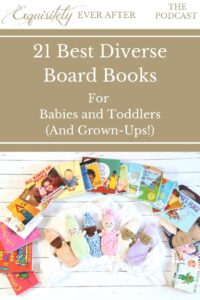
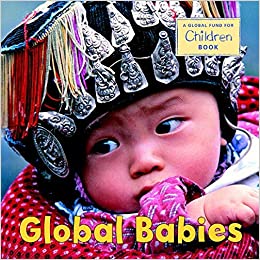
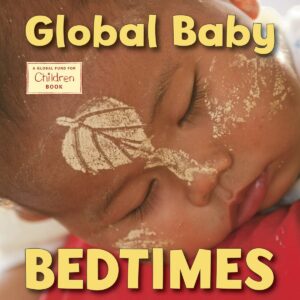
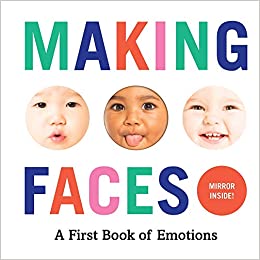
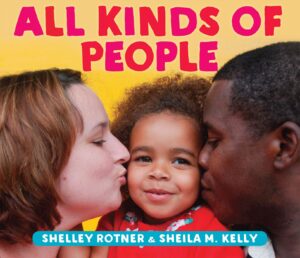
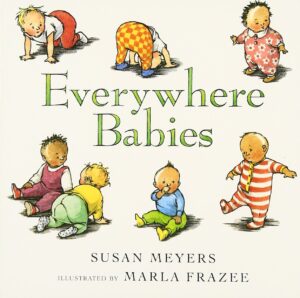
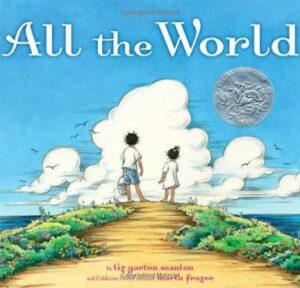
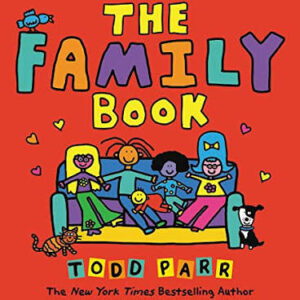
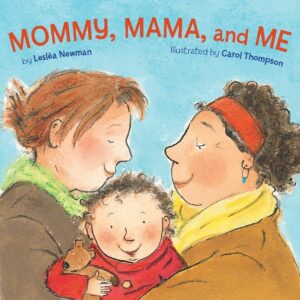
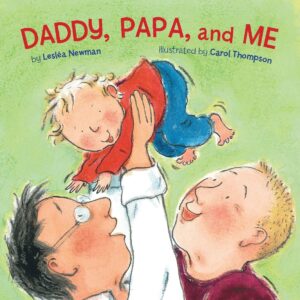
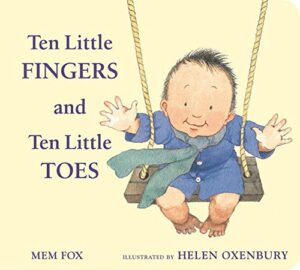
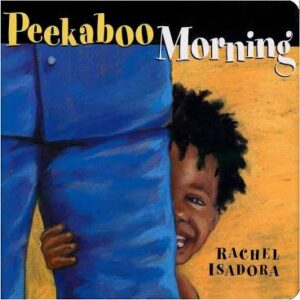

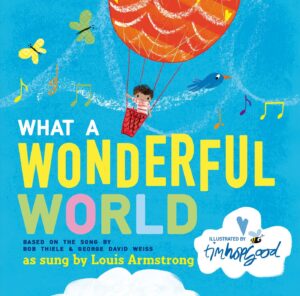
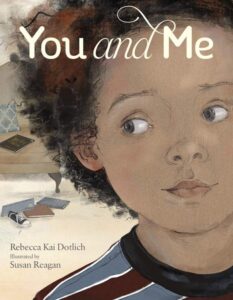
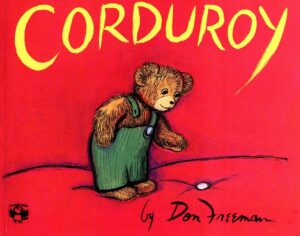
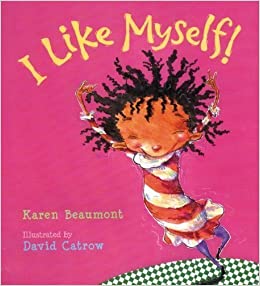

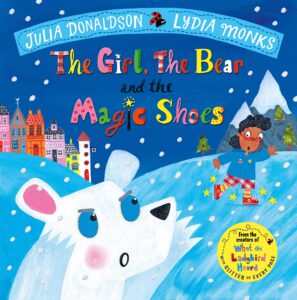
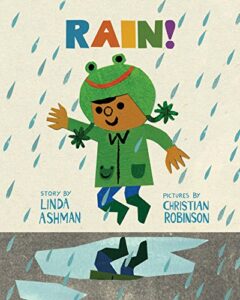

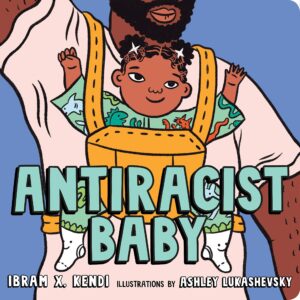
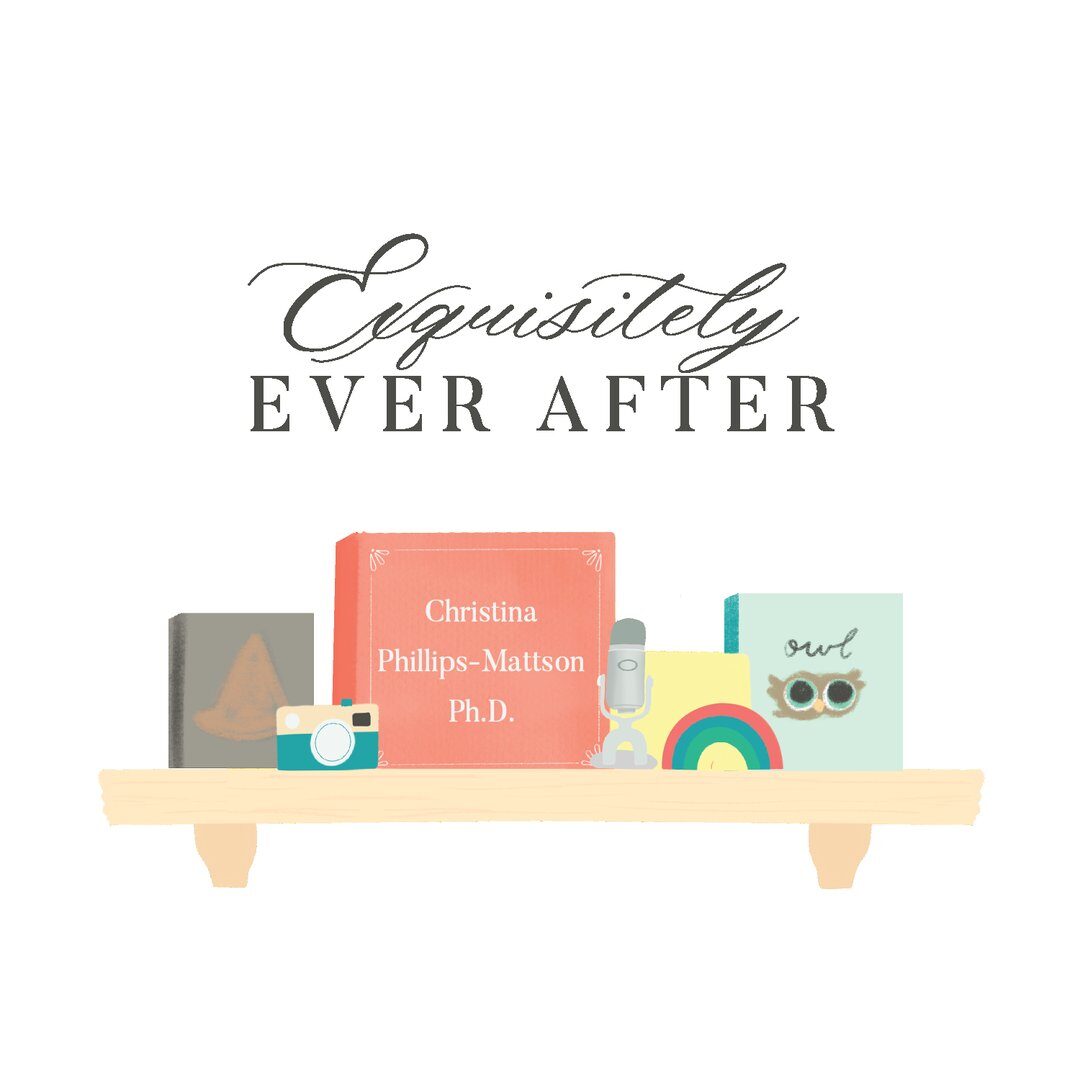

Thank you – so many great suggestions here! Another book for new sibling adjustment is Peter’s Chair by Ezra Jack Keats…we love all of the Peter books, and we especially love this one!
Thanks so much, Becky!! And thank you for the rec- I will definitely check out “Peter’s Chair!” We have and love “A Letter to Amy,” but not that one. Miss you! Sending love and hugs to you and your adorable family!